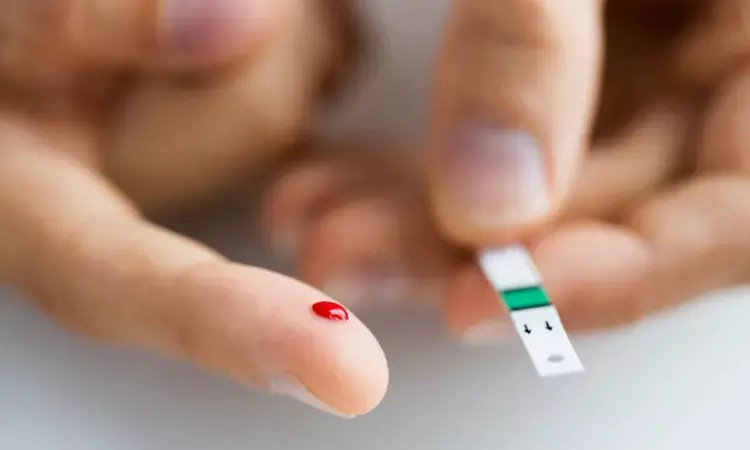- Home
- Medical news & Guidelines
- Anesthesiology
- Cardiology and CTVS
- Critical Care
- Dentistry
- Dermatology
- Diabetes and Endocrinology
- ENT
- Gastroenterology
- Medicine
- Nephrology
- Neurology
- Obstretics-Gynaecology
- Oncology
- Ophthalmology
- Orthopaedics
- Pediatrics-Neonatology
- Psychiatry
- Pulmonology
- Radiology
- Surgery
- Urology
- Laboratory Medicine
- Diet
- Nursing
- Paramedical
- Physiotherapy
- Health news
- Fact Check
- Bone Health Fact Check
- Brain Health Fact Check
- Cancer Related Fact Check
- Child Care Fact Check
- Dental and oral health fact check
- Diabetes and metabolic health fact check
- Diet and Nutrition Fact Check
- Eye and ENT Care Fact Check
- Fitness fact check
- Gut health fact check
- Heart health fact check
- Kidney health fact check
- Medical education fact check
- Men's health fact check
- Respiratory fact check
- Skin and hair care fact check
- Vaccine and Immunization fact check
- Women's health fact check
- AYUSH
- State News
- Andaman and Nicobar Islands
- Andhra Pradesh
- Arunachal Pradesh
- Assam
- Bihar
- Chandigarh
- Chattisgarh
- Dadra and Nagar Haveli
- Daman and Diu
- Delhi
- Goa
- Gujarat
- Haryana
- Himachal Pradesh
- Jammu & Kashmir
- Jharkhand
- Karnataka
- Kerala
- Ladakh
- Lakshadweep
- Madhya Pradesh
- Maharashtra
- Manipur
- Meghalaya
- Mizoram
- Nagaland
- Odisha
- Puducherry
- Punjab
- Rajasthan
- Sikkim
- Tamil Nadu
- Telangana
- Tripura
- Uttar Pradesh
- Uttrakhand
- West Bengal
- Medical Education
- Industry
Diabetes patients with higher BMI also have higher saliva and blood glucose levels

USA: A recent study published in the Journal of Pharmacy and Bioallied Sciences has shed light on the correlation of body mass index with saliva and blood glucose levels in non-diabetic and diabetic patients.
The researchers discovered that patients with diabetes mellitus (DM) who have higher BMI levels also have higher blood glucose and salivary levels; implying that patients who have a higher BMI are more likely to develop diabetes. They stress the need for additional research with larger populations in various geographic locations.
Saliva can be used for several diagnostic purposes. Additionally, it helps epidemiologic studies and large-scale screening for different diseases. Now, bodily fluids other than blood and urine as used for diagnostic purposes, such as tears, saliva, and sweat.
Obesity is the most common risk factor for various diseases including diabetes, hypertension, and dyslipidemia. Diabetes has been associated with altered salivary function and composition. Several past studies have shown a connection between higher salivary glucose levels and diabetes. Most investigations revealed lower salivary flow rates in diabetes or similar values in both non-diabetics and diabetics.
In the study, Bhumika J Patel, Department of Oral Medicine and Radiology (MDS, DDS), Private Practitioner, Ewing, New Jersey, USA, and colleagues aimed to compare and correlate the relationship between BMI and blood and salivary glucose (mean values) in patients with diabetes and non-diabetic control group patients.
For this purpose, the researchers randomly selected 50 diabetic patients and 50 healthy subjects. Patients with well-established cases of all types of DM were included as per standard guidelines. For healthy control, non-diabetic patients with normal blood glucose levels were selected.
The researchers conducted the study after obtaining the written consent of the subjects. The information was collected by a short medical history and questionnaire including a thorough patient history. Both healthy and diabetic study participants submitted average plasma glucose and salivary glucose samples. According to WHO classification, subjects were categorized under 3 BMI categories.
The researchers reported the following findings:
- In comparison with the non-diabetic patient group, the average plasma glucose (mean) in diabetic patients was higher. Similar to this, patients with diabetes had salivary glucose reported higher compared to non-diabetic patients (4.61 ± 2.58 mg/dl versus 13.96 ± 7.09 mg/dl).
- The mean BMI in patients with diabetes was higher (27.06 ± 3.60) than the mean BMI in healthy patients (22.47 ± 0.99).
- Compared to healthy patients, diabetic patients have statistically significantly higher levels of salivary glucose, average plasma glucose, and BMI.
- The mean BMI of the normal group (diabetic patients) is 23.70, the pre-obese group (diabetic patients) is 27.16 and the obese group (diabetic patients) is 32.11.
- There is a significant correlation between the value of BMI and the mean average plasma glucose and mean average salivary glucose level. As the value of BMI increased from normal, pre-obese to obese group, the value of average plasma and salivary glucose levels also increased.
- Significant positive correlations were present between BMI with average plasma glucose and salivary glucose in patients with diabetes.
- Salivary glucose and average plasma glucose have a favourable correlation with BMI.
- In diabetic patients, salivary glucose also demonstrates a favourable correlation between BMI with average plasma glucose.
- There is a favorable correlation between BMI and average plasma glucose and between BMI and salivary glucose levels but it is significantly less pronounced in non-diabetic patients than in patients with diabetes.
The researchers concluded, "Patients with a higher BMI are more likely to develop diabetes. There is a need for additional research with larger populations in various geographic locations."
Reference:
Patel, Bhumika J1; Mehta, Dhaval N.2; Vaghani, Ansee3; Patel, Keyur4. Correlation of Body Mass Index (BMI) with Saliva and Blood Glucose Levels in Diabetic and Non-Diabetic Patients. Journal of Pharmacy and Bioallied Sciences 15(Suppl 2):p S1204-S1207, July 2023. | DOI: 10.4103/jpbs.jpbs_159_23
Dr Kamal Kant Kohli-MBBS, DTCD- a chest specialist with more than 30 years of practice and a flair for writing clinical articles, Dr Kamal Kant Kohli joined Medical Dialogues as a Chief Editor of Medical News. Besides writing articles, as an editor, he proofreads and verifies all the medical content published on Medical Dialogues including those coming from journals, studies,medical conferences,guidelines etc. Email: drkohli@medicaldialogues.in. Contact no. 011-43720751


